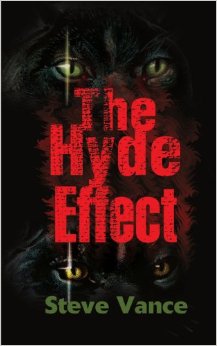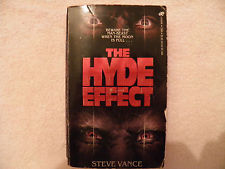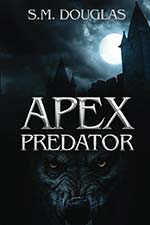Here we are! Two weeks ago I started this look at top werewolf books by analyzing my number three choice: The Howling. Last week The Wolfen clocked in at number two. Today, and just in time for ordering your loved one a X-mas copy, is my top choice: The Hyde Effect.
First my obligatory commentary on the cover. The cover above is from the 2000 reprint. It’s not bad, but the edition I have from the book’s original publication in 1986 features the following cover:
Notice the difference. I hope you do, because the original more accurately conveys the shape shifting premise offered by the title. As an aside, sorry for the lousy picture, but for whatever reason I struggled to find online a better image. They say a good cover is worth a thousand words, and the problem I have with the 2000 version is that it looks like a duplicated shot of a wolf. If I am looking for a werewolf book and I see this cover I might just skip on by thinking “Hyde Effect and two wolves on the cover….hmmm….this looks like it could be about maybe a good wolf/bad wolf book, a government experiment featuring two wolves, or something else, but not necessarily a werewolf book.” This is an important lesson for you authors out there, make sure you are actively thinking about your book’s core audience and participating during the process of selecting your cover (if you can, some publishers are a bit more….how shall I say “controlling”).
It’s also a lesson to readers. Don’t be turned off by a bad cover; a good book could be lurking inside. Take the time to research or review the book; it might be worth your hard earned dollars. In this case author Steve Vance produced a winner nearly thirty years ago with The Hyde Effect’s first print run. Careful readers will note that since October I have profiled two werewolf books written in the 1970′s (and now one in the 1980’s, plus an honorable mention for another 1980’s book – Stephen King’s Cycle of the Werewolf) and favorably commented on several 1980’s werewolf films. These are big reasons why I consider the ten year’s running from the mid-1970s’ to mid-1980’s as the “golden age” of high quality werewolf themed entertainment. Now back to my review, and a note on methodology.
You may be wondering what criteria landed The Hyde Effect at number one on this list. After all, both The Howling and The Wolfen sold more books, and each spawned major feature films. The answer is quite simple: by a muzzle The Hyde Effect edged out The Wolfen as the scariest of the three books. And I mean by a muzzle. The Wolfen came close to taking the top spot. And don’t think that I elevated The Hyde Effect to number one just because it meets some contrived purist’s definition of featuring a supernaturally created shape shifting werewolf. If you believe that then you are ignoring my wholehearted endorsement of The Wolfen, and it’s non-werewolves.
The werewolf in The Hyde Effect and the carnage he wreaks rises several terror notches above this book’s closest competitors. The Wolfen are scary to be sure, but they are basically predators. That means there is a reason for their killing; to eat and survive. Nothing more, nothing less. What’s more they kill only what they need, and just like real predators focus on the weakest and most isolated of their prey species. The only reason they kill otherwise is when certain animals make youthful mistakes, or if there is a risk of discovery. And though the werewolves in The Howling are nasty creatures, even when in werewolf form they are able to control their behavior.None of this is true in regards to the savage killing machine Vance has created.
Vance’s werewolf wipes out entire families in their homes, kills cops, doctors, and so on….it butchers people by the dozens. There is no regard for the person’s standing in life, whether or not there are other people nearby, whether or not the werewolf has just fed, or anything of the sort. You can be killed at any time or any place by this werewolf, as long as he is somewhere nearby and the clock has not run out on his monthly killing spree.
One could say how scary is that? It should be easy to find such a mindless terror. But Vance makes his human host a kind, thoughtful, intelligent man who takes all sorts of precautions in attempting to limit his once per month nocturnal activities. Some months he is even successful in isolating himself to such an extant he cannot make a kill. This further drives home the book’s title: Vance’s central character is a true Jekyll and Hyde. This is doubly true not only in terms of personality and morals but also makes him much harder to track than if he were like Gary Brandner’s Marcia; who in The Howling oozes sexuality and violence in whatever form she is in. In addition, by sticking to the conventional script, in regards to his werewolf only being able to change at midnight on the night of the full moon, Vance further limits his creature’s destructive power to a roughly five to seven hour period each month. This allows Vance to ramp up the book’s tension. Each month the full moon approaches, bringing the reader to a near feverish state of suspense again and again as Vance’s work winds it way through a series of bloody killings to reach it’s final act. And what a final act it is….
Without giving away too much of the plot a good chunk of the book’s second half takes place in a single physical location where the werewolf has an opportunity to feast upon over a hundred trapped people. The idea might sound weak but trust me, Vance makes it work. These people include the book’s heroes, who have been developed enough that by this point in the text you care about what happens to them. On top of that there is a side story running throughout the book about a mentally handicapped teenage boy of prodigious size, physical strength, and the motivation to use his power. He, and his sister who takes care of him, end up trapped with everyone else – where he confronts the werewolf as part of an epic battle running the entire night between werewolf on one side and over a hundred people on the other. Such is the savagery of the beast that it is hardly a fair fight; for the people.
If for no other reason than the book’s second part I cannot for the life of me understand why it has never been made into a movie. And this is not to ignore the book’s first half. As a stand alone read it does a great job of establishing the nature of the beast, the obstacles our heroes must tear down in their quest to reveal the truth of the murderous terror stalking the night, and in setting up the climactic confrontation that follows. If you like werewolves, or if you like feeling scared, you will not be able to put this book down. Does it have its faults? Sure. But in terms of pure entertainment I cannot recommend The Hyde Effect enough.
I first read all three of my recommendations, and Stephen King’s fourth place near miss, as a tween – or YA reader in today’s vernacular. They scared the crap out of me. I think I turned out reasonably well adjusted. Nevertheless, note to parents; none of these book’s were written for those under the age of 17. They all qualify as “R” rated. In particular The Howling contains a disturbing rape scene and graphic sexuality. Though each book is somewhat dated, and though the Internet makes available for viewing sexual practices and levels of violence I couldn’t even dream up back in my youth; this is not Twilight. These are violent, scary works whose monsters still managed to put a fright in me when I reread each book as an adult. You are forewarned.
Now go forth and shop (or load up your browser, click on a few buttons, and call it shopping). Merry Christmas!



Recent Comments